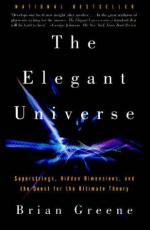
|
| Name: _________________________ | Period: ___________________ |
This test consists of 15 multiple choice questions and 5 short answer questions.
Multiple Choice Questions
1. What is a string's winding number?
(a) The number of other strings it is threaded with.
(b) The number of dimensions it vibrations through.
(c) The number of times it is wrapped around a circular dimension.
(d) The ratio of its Planck tension to its tension at rest.
2. Which of the following is true regarding tears in space time occurring in normal three-dimensional space?
(a) They cannot occur.
(b) It has been proven that they can occur.
(c) Such tears have been observed in particle accelerators.
(d) It is unknown whether or not they can occur.
3. According to the standard model of the big bang, which of the following is true of the four fundamental forces during the first moments of the universe?
(a) They were all melded together.
(b) They were "evaporated" in the high temperature, and didn't interact with space-time.
(c) They were divided into eight unidentified forces.
(d) They were not uniform throughout space.
4. What is the scientific state of the "multiverse" theory?
(a) It is on the fringes of physics.
(b) It was discarded years ago.
(c) It is accepted by almost all young physicists, but almost no older ones.
(d) It is well accepted by the physics community.
5. What is entropy a measure of?
(a) The energy lost by a black hole.
(b) Disorder.
(c) Heat and pressure.
(d) Energy lost over time.
6. When a black hole's entropy increases, which of its characteristics increases as well?
(a) Its electrical charge.
(b) Its spin.
(c) The surface area of its event horizon.
(d) Its nuclear-weak force charge.
7. The extra dimension or dimensions in M-theory are needed in order to incorporate _____.
(a) Electroweak duality.
(b) Electromagnetism.
(c) Unwound Calabi-Yau spaces.
(d) Supergravity.
8. The method of tearing space-time discovered by Greene and others is called _____.
(a) Quantum collision.
(b) Space-tearing wormhole formation.
(c) Spontaneous tunneling reaction.
(d) Space-tearing flop transition.
9. It is believed that early on, the universe experienced symmetry breaking, meaning that _____.
(a) The universe expanded very rapidly for a short time.
(b) Three of the space dimensions expanded asymmetrically compared to the others.
(c) Quantum fluctuations caused different expanding areas to have different energy densities.
(d) The three non-gravitational forces were separated out.
10. How are black holes are widely believed to have originated?
(a) Through the phase transition of normal elementary particles.
(b) From the collapse of a star.
(c) Spontaneously from quantum foam.
(d) From the collision of stars.
11. Which of the following is true regarding the force of gravity in string theory?
(a) Gravity in string theory is stronger than what we actually observe.
(b) Gravity is not addressed in string theory.
(c) Gravity in string theory acts over much longer distances.
(d) String theory predicts gravity.
12. Which of the following most accurately describes the state of the universe?
(a) It is mostly static.
(b) It is expanding.
(c) It is collapsing.
(d) It is about to begin contracting.
13. Which of the following will occur after the collapse of the universe as predicted by string theory?
(a) The universe will expand again.
(b) The universe will be mirrored in another dimension.
(c) The universe will cease to exist.
(d) The universe will become a single black hole.
14. Which of the following is NOT a property that is used to define both black holes and elementary particles?
(a) Spin.
(b) Half-life.
(c) Mass.
(d) Force charge.
15. At what scale of length is quantum geometry necessitated?
(a) Cosmological scales.
(b) Nanometers.
(c) The Planck length.
(d) The Riemann scale.
Short Answer Questions
1. Which of the following methods has been used to determine the shape of the Calabi-Yau space?
2. Under string theory, which of the following is true regarding extra dimensions?
3. Kaluza's theory suggested that electromagnetism was carried by ripples in _____.
4. What property does an external black hole have?
5. What materials were formed during the period of the big bang known as the "primordial nucleosynthesis"?
|
This section contains 683 words (approx. 3 pages at 300 words per page) |

|




